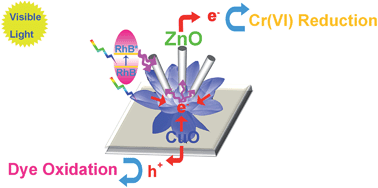The development of visible-light-responsive catalysts with efficient recyclability is important for solar energy conversion applications. Here, we report a three-dimensional (3D) heterohierarchical device consisting of two-dimensional (2D) p-type narrow bandgap semiconductor CuO nanosheets and one-dimensional n-type wide bandgap semiconductor ZnO nanorods that was fabricated via hydrothermal reaction after in situ crystallization on Cu foil. This heterostructured composite exhibited significantly enhanced visible light photocatalytic reduction capacity with stable recyclability to hexavalent chromium (Cr(VI)) compared with pure CuO nanosheets and ZnO nanorods. This improved photocatalysis was attributed to the synergistic actions of CuO and ZnO consisting of their formed p–n hetero-interface for the extension of solar absorption and the anti-recombination of photogenerated electron–hole pairs, demonstrating the potential for p–n heterostructures to be used for solar photocatalytic pollutant degradation or energy conversion. Moreover, the control of the photogenerated electron reservoir cultivated on ZnO nanorods over the photocatalytic reduction activity was demonstrated, further clarifying the photocarrier dynamics and the photocatalytic mechanism in the CuO–ZnO heterojunction. The preparation of the 3D CuO–ZnO p–n junction device could provide a brand new approach to design versatile devices for solar energy conversion.
